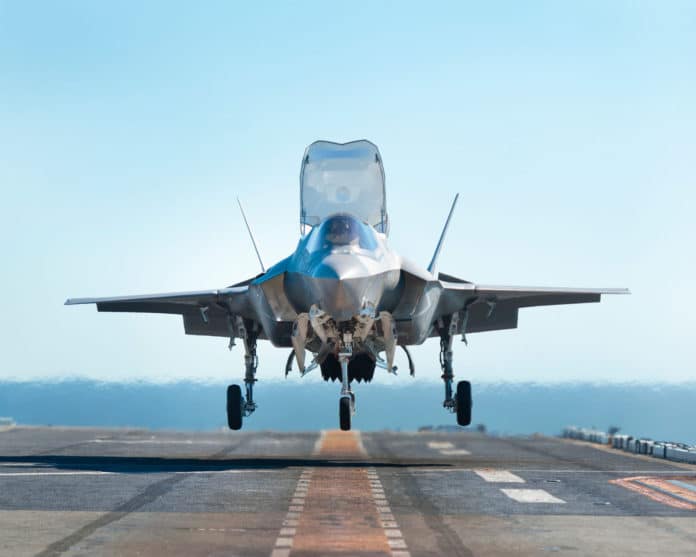Lockheed Martin Corp.’s F-35 has faced plenty of challenges developing the F-35, but Orlando Carvalho, the company’s executive vice president for aeronautics, said that no matter the political party in office, national defense has been a top priority.
“Here in the U.S. both political parties have a very, very strong commitment to national defense,” he said.
President-elect Donald J. Trump has at times raised some questions about the expensive and technologically-complex F-35, built at Lockheed’s Fort Worth plant.
“We work with both political parties and the government regardless of whether it is a Democratic administration or a Republican administration,” he said.
Carvalho made his comments while speaking Thursday, Nov. 10 at the Tandy Executive Speaker Series at Texas Christian University.
The F-35 is the costliest U.S. weapons system, projected at $379 billion for a fleet of 2,443 U.S. planes, with others to be sold to partners such as the U.K., Australia, Japan and Italy. While Pentagon officials have said the F-35’s soaring cost has stabilized and its persistent performance problems are lessening, they said earlier in November they will need as much as $530 million extra to finish the plane’s development phase.
Of the original nine partner countries – Australia, Canada, Denmark, Italy, the Netherlands, Norway, Turkey, the United Kingdom and the United States – six have received their first jets and eight have pilots and maintainers in training. In addition, two of the three foreign military sale (FMS) customers, who are Israel, Japan and the Republic of Korea, will receive their first jets this year.
Many of the partner countries that are purchasing the F-35 require some parts to be produced in their countries.
The plane is primarily being assembled at Lockheed’s Fort Worth plant Lockheed said said earlier this year it will build 53 F-35s in Fort Worth and at another assembly in Italy in 2016.
The F-35 is a complicated construction of around 300,000 parts from more than 1,000 suppliers. Carvalho said the supply chain involves nearly every U.S. state and countries around the world.
As a result, Carvalho said, “We have wings form Israel, wings from Italy … you see components from Australia, components from Canada, and that could go on and on … [I]t is very much an international airplane with strong domestic content.:
That means the supply chain requirements for the program are high, he said.
Asked by Neeley School of Business Dean Homer Erekson about leadership, Carvalho said he is a believer in servant leadership and says there is one key to good leadership: listening.
“In my experience, if you don’t start listening, you don’t have an appreciation for what the organization is dealing with, what the culture might be and what the issues might be,” he said. “When you listen, you learn a lot. When you listen, you learn and that helps you learn what you need to do as a leader.”
Speaking recently to a group of employees with 50 years’ worth of experience at Lockheed, Carvalho said he was pleased to hear that they thought the organization was doing a better job of listening to employee concerns.
“That wasn’t the way it used to be,” he said.
Carvalho also noted that Lockheed Martin has three fundamental values that are stressed throughout the organization.
• Do what’s right.
• Respect others.
• Perform with excellence.
As for developments in the future for Lockheed, Carvalho said the company just received a contract from NASA to develop low sonic boom technology.
Current, because of several rules, jets are not allowed to exceed the speed of sound over the U.S. “We would all be annoyed,” said Carvalho.
“But What if you could exceed the speed of sound without a sonic boom?,” he asked.
In March, NASA awarded a $20 million contract to Lockheed for development of a preliminary design for a quiet demonstration passenger aircraft designed to fly faster than the speed of sound.
“Our Skunk Works is doing the earl engineering, but we’re hoping it’s going to lead to a prototype to demonstrate this low sonic boom capability,” Carvalho said.
That technology would translate well to commercial aviation, he said.
“We could go from jet engines to supersonic and all of the sudden we’re flying across the country and instead of a 5 or 6 hour flight, it’s a 2 to 3 hour flight, maybe even less,” he said.
Carvalho gave the attendees a short history of Lockheed’s Skunk Works division. Skunk Works is responsible for a number of famous aircraft designs, best known perhaps for the U-2 and the Stealth Fighter. Led by Kelly Johnson for many years, he set the tone of the Skunk Works philosophy of “Quick. Quiet. Quality,” said Carvalho. The U-2, a high-altitude spy plane was developed, basically from available parts, in 6 months, said Carvalho. “Typically the development of a new plane is measured in years, many years,” he said.
Asked a question about the possibility of fighter jet drones, Carvalho said he thinks fighter aircraft will always have a need for a pilot.
“I do believe the role of unmanned will grow,” he said.
On scenario that has been discussed is having a manned aircraft controlling a number of unmanned aircraft. “You could see 2 to 3 manned aircraft with then 10 to 12 unmanned, with the pilots controlling the unmanned,” he said.
For more on Skunk Works:
www.lockheedmartin.com/us/aeronautics/skunkworks.html






